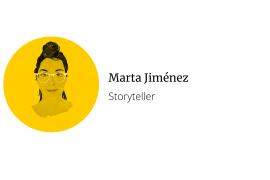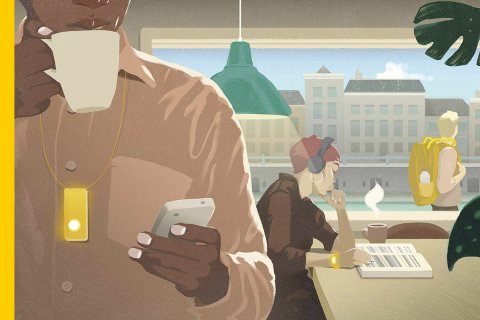Babies born too soon or after complications around birth are surviving at higher rates than ever before. But, because their brain development is disrupted, as much as half of them might face long-term health, mental and developmental disabilities, including difficulties with language, learning, emotional regulation, social functioning and behaviour. Scientists in Utrecht are starting to unravel the relation between brain and child development, while trailblazing new ways to reduce the lifelong consequences of a tough start in life: from regenerative medicine and neuroprotective care to pedagogical interventions and parenting support programmes.
Beyond survival
How to help children thrive after a rough start?
Estimated reading time: 14 minutes

Overnight, Nathalie and Paul noticed something was wrong. Their daughter Julia, just 30 hours old, had a fever and a racing heartbeat. On the urgent advice of the midwife, they rushed to the hospital in Enschede, the most eastern city in The Netherlands.
Julia had suffered a brain infarct – doctors told them – so she was admitted immediately. "Without a child, we were sent home. At one point, we thought Julia had died,” Nathalie says, wishing her words can carry the dreadfulness of that moment, two new parents, left in the dark. “Hours later we received a call to inform that she was being transferred to another hospital in Zwolle because she was deteriorating. There they arranged another incubator transport to yet another hospital: the Wilhelmina Children's Hospital in Utrecht,” Nathalie recounts.

Fortunately for Julia and her family, the Wilhelmina Children’s Hospital, a part of the University Medical Center Utrecht (WKZ- UMC) had recently started an experimental treatment with the drug erythropoietin, a promising agent based on regenerative medicine, to determine whether damage to the brains of newborn babies after an infarction can be limited.
This [medication] is groundbreaking, because damage to brain tissue was considered irreversible
"The medication has to be administered in the first week to ten days after birth. This window of opportunity seems to increase the developmental chances of children with a brain infarct the most. The medicine causes nerve cells in the brain to repair,” says Manon Benders, neonatologist at UMC Utrecht, who treated Julia at the time. “This is groundbreaking, because damage to brain tissue was considered irreversible."
Julia was one of the first babies to be treated with this medication. Natalie: "We knew it was an experimental drug, but we thought: if there’s a chance to save our child, we’ll take it. I also had a strong feeling that Julia would make it. Perhaps I was more positive than the doctors themselves”.
Doctors’ prognosis was grim. There was a high chance that Julia would develop cerebral palsy, a lifelong disability that affects body movement and coordination, and a long list of potential handicaps.
Against all odds, Julia recovered very quickly and was allowed to go off the supporting equipment at the neonatal intensive care unit. “Underneath that purple turban with plugs, a beautiful girl with red hair emerged,” recounts Nathalie with a smile. Over the first year, Julia continued to recover successfully. “Every developmental leap – the moment she lifted her head, started crawling, standing, walking – were moments of jubilation,” her mother says.
Today Julia is a cheerful, spirited 11-year-old, who can often be found at the riding school. “I prefer to be surrounded by horses,” she says, hopping and bouncing around her living room. Julia herself cannot remember the period in hospital. But she was shocked when her parents told her about it later. "If I had not fought so much, I would not be sitting here on the sofa,” she says modestly.
A decade has passed and the medical research at WKZ- UMC is now in the next trial phase with another medication which shares the working mechanism of erythropoietin (DINOSAUR study). In order to demonstrate its effectiveness in restoring or reducing brain damage after an infarction, half of the children are administered the medicine darbepoetin by lot. The other half will receive a placebo as a control medicine. Manon Benders: "Parents and children do not know who gets which medicine. The medical team does not know either. That is the foundation of double-blind trials, that aim to minimise all sort of biases. We continue to follow all children who participate in the trial in a cohort study. This follow-up is extremely important to know how these children are doing in the long term, in terms of learning ability, motor development and behaviour."
The extent of the problem
We know that 30 to 50 percent of children with a tough start will face developmental disabilities
Thanks to this and other pioneering treatment studies that are underway at the WKZ, researchers in Utrecht hope to prevent or limit the severity of developmental problems associated with this group of patients. Because newborns who, like Julia, have a stroke or infants who are born before term age are at increased risk of altered brain development, which may lead to a host of developmental delays and problems such as ADHD, autism and anxiety, language, learning and behavioural impairments.
“We know that 30 to 50 percent of children with a tough start will face developmental disabilities,” says neonatologist Benders. That’s a big percentage of the population, considering that more than one in ten children are born prematurely.
These children will carry the burden of a tough start, often for the rest of their lives. Studies have shown that up to two thirds of babies affected by a stroke will develop learning or developmental problems; 78% of extremely premature babies (born before 32 weeks of gestation) manifest a chronic health condition in adolescence or early childhood, such as mood or anxiety disorders, compared with 37% of those born full-term; about 40% of moderately premature babies (32-37 weeks of gestation) show difficulties with attention and focus as early as 18 months, and by the time they reach the age of eight, these children are almost three times as likely to require special education. However, children born prematurely show great differences in their outcomes. “We just don’t know for sure who will face difficulties and who will not, or who will need extra support to thrive just as much,” says Benders bluntly.
New insights from cohort studies
To bridge this knowledge gap, Utrecht University and the University Medical Center Utrecht are investing in large-scale, longitudinal studies that track children from pregnancy into early adulthood. Since 2015, the YOUth (Youth of Utrecht) cohort study aims to follow about 5,000 children and their families from Utrecht and surroundings regularly over time. 3,000 children are to be tracked through an ultrasound at week 20 of pregnancy into the age of six. The other 2,000 children from around the age of nine to around the age of 15 visit the Child Research Center in Utrecht, for at least three times.
“Results from this cohort study will be crucial to identify which children are at high risk of having developmental problems later in life, and which factors are important for child development, including those that promote resilience and well-being,” says principal investigator of the YOUth study, Chantal Kemner.
The YOUth cohort is a big step to better predict which children will develop behavioural, psychological or psychiatric problems
“To this day, there is little insight into how exactly biological, (child-related) psychological and environmental factors interact in shaping brain and behaviour during the course of a child’s development,” explains Kemner, who is professor of Biological Developmental Psychology at Utrecht University and UMC Utrecht. The long-term multidisciplinary approach of YOUth aims to bridge that knowledge gap.”
Data collected ranges from genetic material, neuroimaging (EEG and MRI), eye tracking, computer tasks and behavioural assessments to questionnaires about the environment in which the child grows up. Kemner: “By the time a baby participant at YOUth reaches adolescence, we will have high-quality data to understand which combination of factors are important for key building blocks of a child’s development such as self-regulation and social competence.”
Researchers can now use the data from the YOUth cohort study, a trailblazer for open science, to test hypothesis about the origins of complex diseases such as autism and ADHD, the long-term health outcomes of early brain injury or the effect of early interventions that can support children like Julia in key developmental processes, such as self-regulation. “The YOUth cohort gives us a control database to compare normal developmental processes with those of children with a difficult start. It’s a big step to better predict which children will develop behavioural, psychological or psychiatric problems,” Kemner says. “So that we can intervene early, instead of waiting until the development of the child is well underway.”
The YOUth data enables researchers to look for answers to all sorts of scientific questions on child development. See how it works.
Early prediction of developmental difficulties
Just a few months ago 11-year-old Julia was diagnosed with ADHD – a term for a cluster of symptoms ranging from concentration problems, restlessness, impulsivity or learning difficulties, which affects a great number of stroke patients and premature children. The diagnosis has opened doors for Julia to receive tailored treatment and support, her mother says. With the help of medication and occupational therapy, her concentration has now skyrocketed – and she is excited to start secondary school without fear of being left behind.
[ Read also "We need to rename ADHD" by Utrecht researchers ]
With age, the brain’s plasticity and, with it, the chances of successful treatment diminish
And yet, treating developmental problems earlier can reduce suffering in children and their families, and give them greater chances to thrive. “With age, the brain’s plasticity and, with it, the chances of successful treatment diminish. But while some serious problems are evident from the start, subtle ones don’t reveal themselves until school age or even later in life,” says gynecologist-perinatologist and Professor of Obstetrics at Utrecht University Mireille Bekker.
“New techniques such as brain scans, prenatal screening and non-invasive prenatal testing are becoming very effective in detecting anomalies in unborn children,” says Bekker, who’s using all the resulting information to detect who’s at risk of developing difficulties as early as possible. She collaborates with YOUth researchers screening pregnant women to build a control database of healthy fetal brain development. “This way we can compare brain scans of healthy children with those of children who were born prematurely or had complications around birth and make better predictions of long-term implications of different anomalies.”
Assessing the attention skills of toddlers who were born moderately preterm is another way to identify mechanisms that might contribute to other developmental difficulties, as Lilly Bogičević discovered during her PhD at the Department of Clinical Child and Family Studies (STAP project). Using the Utrecht Tasks of Attention in Toddlers using Eye tracking (UTATE), developed by Marjanneke de Jong, Bogičević found that the assessment of the attentional capacities of children at 18 months predicts their cognitive and behavioural abilities at six years of age. Currently she works as a postdoctoral researcher and collaborates with colleagues from Neonatology and Experimental Psychology to examine how attentional functioning and early brain development are related in extremely preterm born children.
We can induce injury on a brain organoid, and observe what the effects are on the entire developmental process of a human being.
In addition to brain scans and eye tracking, Jeroen Pasterkamp, Professor of Translational Neuroscience at Utrecht University and UMC Utrecht and his team are developing organoids, mini-organs made of human cells, to gain privileged knowledge of the prenatal and neonatal brain. “Not long ago we had to rely on animal models or donated brains from deceased babies to study early brain development,” he says. With organoids, Pasterkamp has been able to model the brain at a level of complexity undreamed of just a few years ago. “The possibilities are plenty,” Pasterkamp explains, “and can help unravel what happens in the brain during the first critical 1001 days in a child’s life: We can use tissue from a patient with a genetic defect and study how the brain develops. Or we can induce injury or trauma on our brain organoid, and observe what the effects are on the entire developmental process of a human being.”

Neuroprotective strategies
While advanced techniques are giving brain researchers powerful tools to predict neurodevelopmental outcomes, and hopefully in the near future prevent their onset, neonatologist at UMC Utrecht Maria Luisa Tataranno thinks some of the most promising interventions following brain injury or prematurity in newborns are those related to care. Together with colleagues at UMC Utrecht, they are researching and testing a myriad of interventions to nurture and stimulate the infants’ brain during these critical and treacherous first days.
“The brains of babies who are admitted to the NICU (neonatal intensive care unit) are even more vulnerable by the many medical procedures and ventilation they need to undergo. Babies in the incubator are also more often deprived from the touch or voice of their parents. But we know from small cohort studies that sensory stimulation can drive structural development of the brain, so our goal is to investigate what we can do at the bedside, that especially when combined, can help promote optimal brain development,” she says.
For example, Tataranno is now running pilot studies for a number of promising nurturing techniques. “We are using classical music therapy and neonatal massages in small groups of premature children to measure the effect of sensory stimulation on the maturation of brain activity. We also try to involve parents in their child’s care, fostering skin-to-skin contact or kangaroo-care during their stay in the NICU.” Tataranno says these interactions promote a strong parent-infant bond that not only helps the child’s developing brain, but also to forge a secure emotional attachment that is the basis for children’s well-being.
Sleep restoration
Fostering a care environment means planning hospital care around the infant’s needs – and their brains. "Unfortunately," says neonatologist at UMC Utrecht Jeroen Dudink, “one of the most critical factors for proper brain development is underestimated: sleep.” Dudink: “In the last trimester of pregnancy, babies’ active sleep lasts for about 22 hours every day when in the womb. But babies that are born too early only get about 16 hours (or less) at a NICU, because of all the medical procedures.”
This level of sleep deprivation is worrying because infants are literally building their own brain while they sleep
During this last trimester, Dudink stresses, infants’ brains are generating connections that are essential for the child’s development of motor maturity, attention, interaction or self-regulation. “This level of sleep deprivation is worrying because infants are literally building their own brain while they sleep. A good sleep is even more critical for preterm infants, who are at the highest risk of adverse neurodevelopmental outcomes,” he says.
Determined to restore these infants’ much needed sleep, Dudink and a team of data scientists of the UMCU and medical specialists have developed a predictive algorithm that can detect whether an infant is asleep or awake and help plan elective care for the newborn accordingly. “That’s not readily apparent, because during their active sleep, babies are often kicking and moving,” he explains. “We hope that the ‘Sleep Well Baby Project’ can display the sleep stage on a monitor bedside so that doctors and nurses can plan their medical procedures, feeding times, change of diaper and care around the baby’s natural sleep cycle,” Dudink adds. “Sleep is a powerful medicine to protect the vulnerable newborn brain.”

How the education system can support children's learning and developmental processes? How can teachers grow their competences to improve early childhood education and care? Find out more about our research into teacher-child education.
Parenting support and social interventions
“We’ve known for years how powerful environmental factors such as nurturing and bonding are in terms of brain development and children’s developmental outcomes," says Professor of Pedagogical Diagnostics at Utrecht University Anneloes van Baar, who has nearly 40 years of experience in clinical research and practice with vulnerable babies. "Providing the right stimulation to very young children will be beneficial their entire lives.”

With the right training or social support, parents themselves can have a much greater impact on their children’s developmental outcomes, shows Van Baar. Back in 2009, her PhD student Dominique Meijssen, together with a team from the University of Amsterdam, demonstrated the effect of a parenting intervention programme to improve very premature children’s motor, mental and behavioral development. The Infant Behavioral Assessment and Intervention Programme, now called ToP, had pediatric physical therapists trained to assist parents in supporting their infants’ needs. Families in the intervention received from six to eight home visits, as well as standard care. “At two and five years of age, the participating children showed faster developmental patterns over the children who had not received the intervention,” Van Baar says.
With the right training or social support, parents themselves can have a much greater impact on their children’s developmental outcomes
Their assessment gave substance for the nationwide implementation of this programme and its full reimbursement by Dutch healthcare insurers. Today, after 12-year implementation, the ToP programme is standard care in The Netherlands, reaching over two thirds of the target population.
“We still have a long way to go to understand in greater detail which mechanisms are at work in development and to identify which care interventions outside the clinic have the greatest impact, particularly on children with such high-risk factors such as prematurity or a stressful birth,” admits Van Baar. “We’re making progress in systematically following-up these children in all areas of development, and in researching and designing assessment instruments that can help us identify early on which children will need, what kind of assistance to blossom."
“What’s encouraging,” says Van Baar in retrospective, “is that the study and care of the newborn in the last decades is no longer confined to ensuring survival of the most vulnerable newborns, but a recognition of the importance of creating positive early childhood experiences for their emotional and behavioural health.” After Julia’s difficult start and the bumps in the road, she has now secured the support needed to reach her full potential – a caring family, a network of doctors, and even the supervisors at the riding school are all helping Julia in her developmental and learning progress. She’s but one example of how an infant’s tough start is by no means destiny with the right support structures.
This is but one example of how a team of scientists from Utrecht University and UMC Utrecht are working with families on novel interventions to predict, treat and eventually prevent the lifelong consequences many children still face after a tough start, so that children like Julia can have the best chances in life. The biggest value of this multidisciplinary approach is that it helps researchers understand as much about the genesis of the difficulties that children experience today as it is about illuminating the alterable conditions in a child’s environment that could improve their developmental trajectory and well-being. Join us in our mission to give all children the best chances in life.

















